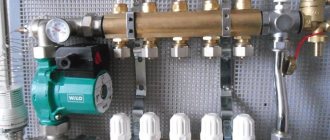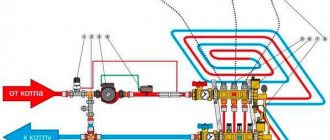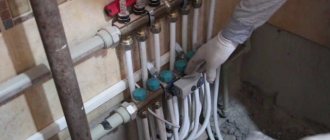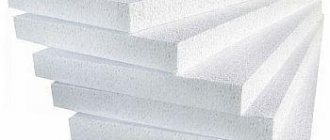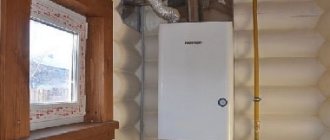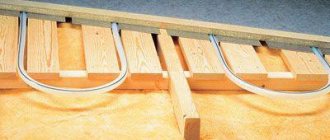How to choose materials?
Warm floors are considered a modern heating method; they are great for additional heating of a home. There are a large number of different materials on the market that you can purchase and arrange the floor yourself.
There are two main types of underfloor heating: electric and water. There is a big difference between them, despite the fact that the purpose is the same.
When considering a water heated floor, you need to understand that the entire system will consist of pipes through which warm water will flow. The pipes are laid under the floor covering, and all the heat is transferred through it.
This case has its drawbacks, for example, in this case it will not be possible to make a heated floor without special permission from the relevant services. The advantage of such a floor is that it saves money; it is convenient to install such a system in a private home.

Electric flooring is more suitable for city apartments. The essence of such heating is that cables, special mats and sections are laid under the floor covering, which heat the floor well.
The main advantage here is that the heating temperature can be adjusted. The disadvantage can be considered the cost of such a warm floor, because heating occurs due to electricity.
Boiler and circulation pump
A boiler is needed when heated floors are installed in a private house. In ordinary apartments this is prohibited, but new buildings, where water-heated floors are provided in advance, require their connection to a separate circuit. A circular pump is necessary in any case, as it ensures the movement of water.
The boiler capacity, pump power, as well as the possibility of connecting an additional one depend on the planned capabilities of the system and are calculated in advance. If desired, you can even purchase a ready-made pumping and mixing group.
Water floor materials
Installing a water floor is quite simple; pipes are laid in the concrete base, through which hot water will then flow; we must remember that it should not be higher than 50 degrees.
This heating method transfers all its heat to the floor covering, thereby creating a favorable indoor climate. Let's consider all the materials for a warm water floor:
- First of all, pipes in diameter may be required; they should be 16-20 mm. The material of the pipes can be very diverse, for example, polyethylene, metal-plastic or even copper pipes are suitable. The most in demand and popular are polyethylene pipes. This material has proven itself to be the lightest and most durable. The main advantage is that leaks are rare, the material is resistant to chemicals and is durable even under high loads;
- You will also need a collector to lay the water floor;
- It is impossible to lay a water-based warm floor without damping tape and waterproofing film;
- To enhance heat, it is imperative to use thermal insulation material, for example, polystyrene foam or mineral wool;
- A reinforced mesh and stands for it will be an excellent assistant;
- In addition, wire and clamps are needed when laying such a warm floor.
We recommend: How to connect a mixing valve for underfloor heating?
When choosing materials for water heated floors, you must not forget about the control system; it allows you to set the desired temperature regime and significantly reduce the amount of energy for heating water.
Thermal insulation
The construction market offers a wide selection of materials that prevent heat from escaping through the floor. There are even special mats designed directly for laying heated floors.

Mats for warm water floors
They come in different thicknesses, have the necessary strength, light weight, and even have a specific surface topography that allows pipes to be positioned and fixed. Of course, it is best to use such products, since they provide all the important nuances.
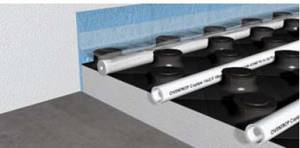
Expanded polystyrene mats for heated floors (with bosses)
This will only have a slight effect on the cost of repairs, since such mats essentially combine thermal insulation, waterproofing, reinforcing mesh and fasteners. Pipes laid in accordance with the chosen scheme must be secured to the floor with special clamps, and the bosses of heat-insulating mats eliminate this need.
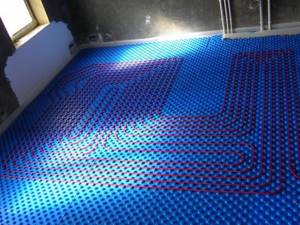
Profile mats for water heated floors
Thin foil materials, for example, penofol, do not provide reliable thermal insulation, so their use only makes sense if the floor has already been insulated in advance and the goal is to save on the thickness of the screed. In addition, it does not have fastenings for pipes, so you will have to lay a reinforcing mesh.
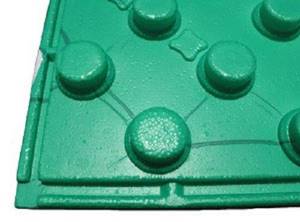
Profile thermal insulation boards are made of polystyrene foam with a density of 40 kg per cubic meter
More advanced are mats made from extruded polystyrene foam. Particularly high-tech options even have markings for laying and a waterproofing layer, and also allow pipes to be secured with brackets.
Video - Mixing unit for heated floors
Materials for electric heated floors
Electric cable underfloor heating is most often used. It is based on a grid of cables laid in the correct order. They must be laid around the entire perimeter.
The cable system must be selected very carefully and carefully, the sheath must be dense, there must be no flammable material, there must be resistance to melting and mechanical damage, this will help to avoid accidents.
There are two types of cables: they can be single-core or double-core. It is better, of course, to opt for the second option, since it has greater resistance; the cable also emits a small amount of infrared radiation, which is also harmful to human health and life.
You can use another type of warm fabric, which is laid using film. It is laid on the floor covering. The main advantage is that there is no need to raise the floors, and there is also a big saving on labor, because you can carry out all the work yourself.
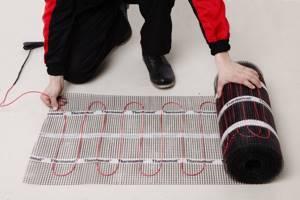
Recently, thermomats have become increasingly used. The essence of such mats is that a heating element called a carbon rod is used, it is attached to the film. No additional sacrifices will be required, for example, you will not have to reduce the height of the room.
The flooring will be mounted directly onto the mat itself using glue. In total, electric heated floors may require:
- heating elements such as cables or mats;
- thermal insulation material;
- material for leveling, you can use foil;
- thermostat;
- temperature sensor;
- you need to use a corrugated pipe;
- electrical wire
Everyone can choose which material to choose for an electric floor based on their budget, which is why materials cost differently.
We recommend: How to install carbon heated floors?
Collector-mixing group
This equipment may be indicated differently in different diagrams. Somewhere there is a separate mixing unit and collector. Somewhere they are united. Or is there only a collector. All of these are working options, they are just selected for different systems.

Various equipment and functions performed
Mixing unit: why and when you need it
As already mentioned, usually a warm water floor is part of the heating system. Moreover, an additional part. Radiators provide the main heat. Hot coolant is supplied to them. Up to 95°C. For heated floors, the maximum temperature is 50°C. To reduce almost boiling water to just hot water, you need a mixing unit.
The mixing group is an adjustable jumper between the supply and return pipelines. With its help, a certain amount of cold is supplied to the hot coolant from the boiler. This reduces the temperature to the set value.

Mixing and pumping unit. Essential item for most water heating systems
This unit usually includes a pump. Even if there is a pump in the boiler, a water heated floor needs its own. This is a system with high hydraulic resistance. And to ensure normal movement of the coolant, you need your own pump that can overcome this resistance.
Is a mixing unit always needed? Not always. It is not needed if coolant with the required temperature comes from the boiler or riser. For example, if there is a condensing gas boiler. Or there is a riser with coolant +40-50°C. In this case, simply place the pump on the supply or return pipeline. And it's all.
Collector and its equipment
The underfloor heating collector (also called a comb) performs several functions at once. The main one is the distribution of the coolant along the supply circuits and its collection at the reception. The most basic pipe with welded pipes can handle this. Or rather, two similar devices. Pipes are connected to the taps. To one is the supply, to the other is the return. Elementary device.

This is what underfloor heating collector groups look like
The necessary components of this unit also include two taps - on the supply and return combs. Through them, the system is filled with coolant and then pressurized (checked with high pressure using a special device). The coolant is drained through the same taps. It is also very advisable to have a pressure gauge here to control the pressure. This is something that is difficult to do without.
It seems clear with both nodes. But why can the group be called a collector-mixing group? Because in most cases both of these nodes are required. Placed separately, one after the other, these are additional fittings. And they are always the most expensive components of the system. And additional connections increase the risk of leakage. That’s why manufacturers make a mixer and a collector unit in one housing. And they call him accordingly.
Flow meters
This option - just a pipe with taps - works normally only if all connected circuits are the same length. This is what experts recommend doing. But in reality it is very rare to plan a system this way. And if the circuits are of different lengths, then they will heat up differently. The hottest will be the shortest. It will have the least hydraulic resistance, so that most of the coolant will flow through this circuit. The coldest, therefore, will be the longest.
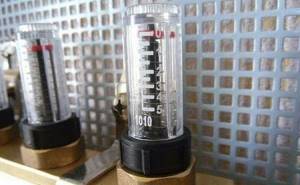
Flow meters are part of the components that allow you to balance the hydraulic resistance of warm water floor circuits of different lengths
To avoid such a picture, flow meters are installed at the supply level, which equalize the hydraulic resistance of the circuits. They are placed on each of the circuits. All they do is, if necessary, reduce the clearance, which increases hydraulic resistance. In this way, the intensity of coolant movement along contours of different lengths is equalized.
Thermostats
There is another device that is placed on the taps of the heated floor collector. These are thermostats. Can be manual or servo driven. You will have to turn manual ones yourself, but servo drives require a thermostat with a temperature sensor from which the control wires are pulled. The system turns out to be more expensive and difficult to install, but also provides a higher level of comfort. With such a device, you can set the floor temperature in each room independently of the others.
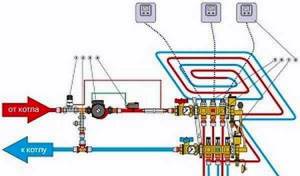
The device of a warm water floor with the ability to automatically adjust its temperature
In this case, you can control either the floor temperature (the sensor is installed in the screed) or the air temperature. The latter option is used if a warm water floor is the main source of heat.
Material that is needed for both water and electric floors
Regardless of whether the heated floors are electric or water, additional material will be required. The set of materials also depends on the installation method, because there is a dry screed and a “wet” screed. In any case, you will need the following material:
- thermal insulation. In this case, polystyrene foam is suitable. It is laid along the walls;
- It is advisable to take care of the heat-reflecting layer. It is not mandatory, but as sellers say, it can significantly reduce the cost of heat, which will be directed downward, and in this case the heat will begin to flow upward;
- you should take care of the fastening system, it can be different for the elements, for example, for film and rolled floors it is enough to use adhesive tape or staples; if pipes and cables are laid, then different types of fastenings are suitable.
Insulating the floor with cork
Most often, manufacturers of heated floors recommend using natural sheet cork for thermal insulation. In many ways, the properties of cork allow it to be considered one of the best insulation materials. The advantages of cork as insulation include:
Energy and heat capacity of floors with a minimum amount of wasted insulation material. No serious deformation after pouring the floor with concrete screed. Environmentally friendly material. Does not change volume when temperature changes.
The main disadvantage of this material is its price category. Compared to other heat-insulating materials, sheet cork in place with aluminum foil (1 mm thick) will cost you 3 times more. Read: how to calculate the electrical consumption of a heated floor.
Insulation for heated floors
Thermal insulation for underfloor heating is important. If the floors are warm underneath themselves, then you can use a small layer of 20 mm for insulation; if they are cold, then no less than 50 mm.
In the northern regions, 100 mm thick insulation is generally used. For any type of heated floor, the following insulation is suitable:
- polystyrene foam in rolls and slabs. It is distinguished by its high thermal conductivity and has a wide temperature range of use. Such material is not susceptible to damage by bacteria;
- cork covering is used in a roll or as slab insulation. Has excellent thermal insulation properties. But, unfortunately, this material also has disadvantages: it is not advisable to use the material in rooms with high humidity, it rots easily, and bacteria multiply well in it. Cork is considered a natural covering;
- mineral wool. This material can be produced as mats and rolls. Of course, it is more suitable for insulating ceilings and walls. The big disadvantage is that it is highly hygroscopic, that is, when the material gets wet, it simply loses all its properties. As soon as the mineral wool begins to dry out, the properties are restored, but not completely. If you lay mineral wool insulation in a screed, then under the weight it can close, and the thermal insulation properties accordingly deteriorate;
- Expanded polystyrene is used much more often as insulation. This is exactly the material that can satisfy all requirements. The most important thing is that it is easy to install; it comes in the form of slabs that have special locks for connection.
We recommend: What are the advantages of Thermo heated floors?
A few words about thermal conductivity
The thermal conductivity of floor coverings varies. To clearly understand which of the alternative options, we recommend that you look at the table below.
| Material type | Thermal conductivity index, W/mK |
| Tiles, granite, ceramics | 1,05 |
| Regular linoleum | 0,2 |
| Parquet | 0,15 |
| Carpet covering | 0,12 |
| Laminated panels | 0,1 |
| Cork covering | 0,034 |
Therefore, when choosing the type of floor covering, you need to know exactly the operating features and the type of construction of the heated floor, in particular.

Laminate floor heating Source kontakt-keramika.ru
Material calculation
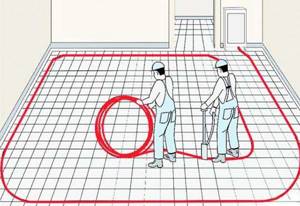
The calculation of the material should be done taking into account all the issues that may arise during installation, for example, it is important to remember that there can be a dry screed, or it can be “wet”. Also, pipes and wires can be laid in a snake, snail, double spiral, loop, and this is a completely different material consumption.
- Related Posts
- What are the advantages of Thermo heated floors?
- What types of mats are there for heated floors?
- How are pipes for underfloor heating made of cross-linked polyethylene laid?
- How to install Eastec heated flooring?
- What are the characteristics of Rehau pipes for underfloor heating?
- What characterizes Rehau underfloor heating?
Material selection
Before choosing one of the coatings, it is worth considering some requirements that it must meet:
- take into account increased humidity;
- stable temperature changes;
- loads that occur from falling objects;
- splashed liquids (often aggressive);
- abrasion of the surface due to frequent visits.
Types of floor coverings and their features:
Linoleum
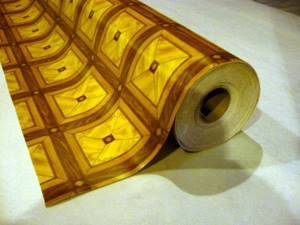
Linoleum is a common material that is found in many kitchens.
A coating that has all the above-mentioned qualities. It easily spreads directly onto the screed, without requiring any special skills. Manufacturers offer products in any color, which will help you choose the best linoleum for even the most sophisticated interior. Of course, there are also disadvantages, for example, dents that remain from leaving heavy furniture (refrigerator or washing machine) in one place for a long time. But in cases where a reshuffle is not expected, you can use this option.
Laminate
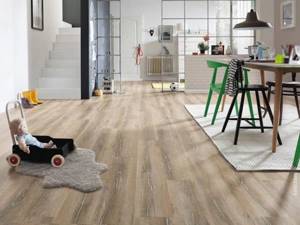
Laminate is an inexpensive and beautiful material with good performance
Laminate floors can be called a cheap alternative to wooden parquet. It should not be surprising that this material is recommended as a covering for the kitchen. The previous disadvantages of finishing the kitchen with laminate, namely the lack of resistance to moisture, which caused delamination, have long been corrected. In stores there is a large selection of moisture-resistant models that imitate not only wood, but also stone or granite. Proper installation will also help to reliably protect the coating from moisture.
Instructions:
- A special leveling substrate is placed on the concrete screed under the laminate, the joints of which are connected with tape.
- Laying the first plank begins along the wall, with a gap of 10 mm remaining between the wall and the plank, which will subsequently help compensate for the deformation of the coating that occurs during operation.
- The next panel is inserted into the groove on the short side and secured with a lock (you can increase the strength of the connection using a special hammer that has a plastic attachment).
- After the first row is assembled along the entire wall, we proceed to the next one, taking into account that the seams should shift by ½ of each subsequent panel.
- The last panels are cut off, and the cut itself is hidden behind the baseboard (it is worth considering that there should also be a small gap between the laminate and the baseboard, which is compensated when the laminate expands).

Crocodiles live only in warm environments.
The substrate should not interfere with the passage of heat, so before purchasing it, the seller should definitely mention that it will be laid on a warm floor.
Do not be alarmed if you purchased an adhesive coating option. The installation rules remain the same, with the difference that glue is poured into the grooves.
Parquet
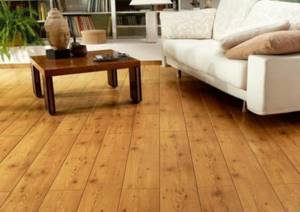
Natural wood always means comfort and coziness
For the kitchen, it is recommended to choose parquet in the form of tiles; this will give a special effect, emphasizing the status of the owners. Much attention should be paid to the wood itself. Elements made from hardwood are considered more durable in operation, and the best purchase is when all modules are made of thermowood. This wood is processed and dried at high temperatures, which makes it possible to achieve a dense and durable material.
Tile
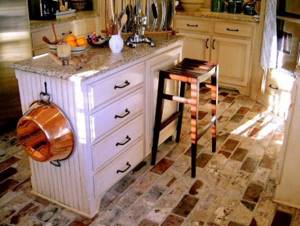
Ceramic tiles are the best material for kitchen floors
Tiles can also be a good option, the only drawback is that a strong impact can cause a crack to form on its surface. Installing heated floors under tiles is not difficult.
- first of all, the floor is cleaned of possible debris and dust;
- the glue is prepared in small portions and applied to no more than 1 m², as it has the property of quickly losing its stickiness;
- glue is applied to the floor with special notched spatulas (for greater reliability, you can apply it to the tile itself, while not forgetting that it must be applied perpendicular to the grooves on the tile);
- when applying the tile to the base, press it quite firmly (remember to remove any excess glue that has appeared);
- to control the distance between all elements, plastic crosses are inserted into the gaps;
- During the entire process, it is necessary to control the level of the tiled floor using a level (the height of the tile is controlled by the thickness of the glue underneath);
- upon completion, the entire surface is cleaned;
- The seams are grouted a few hours after installation with a special grout, which must be selected with increased strength.
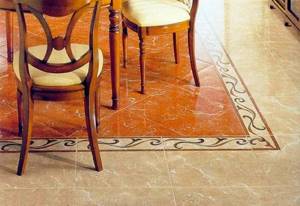
Ceramic tiles amaze with their diversity
It is better to choose the design of floor tiles for the kitchen with a relief or matte surface. This will help avoid injury if the tile is wet after liquid is spilled on it.


